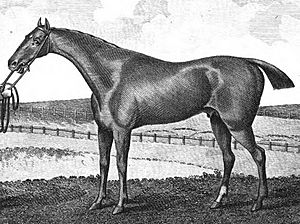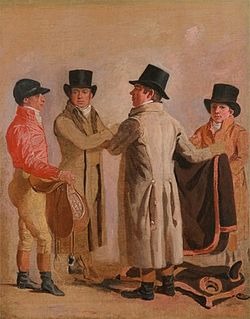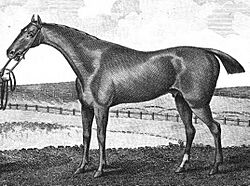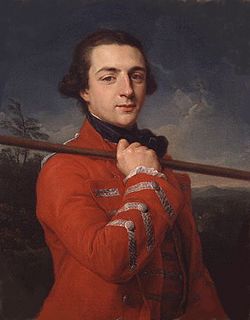Waxy (horse) facts for kids
Quick facts for kids Waxy |
|
|---|---|

Engraving of Waxy based on a painting by Francis Sartorius.
|
|
| Sire | Potoooooooo |
| Grandsire | Eclipse |
| Dam | Maria |
| Damsire | Herod |
| Sex | Stallion |
| Foaled | 1790 |
| Country | Kingdom of Great Britain |
| Colour | Bay |
| Breeder | Sir Ferdinando Poole |
| Owner | 1) Sir Ferdinando Poole (1790–1804) 2) 3rd Duke of Grafton (1804–1811) 3) 4th Duke of Grafton (1811–1818) |
| Trainer | Robert Robson |
| Record | 15: 9-3-2 |
| Major wins | |
| Epsom Derby (1793) | |
| Honours | |
| Leading sire in Great Britain and Ireland (1810) | |
Waxy (born 1790 – died 18 April 1818) was a famous British Thoroughbred racehorse. He won the important Epsom Derby race in 1793. Waxy also became a very important father (called a sire) to many racehorses in the late 1700s and early 1800s.
Waxy was born in 1790 at Lewes, bred by Sir Ferdinando Poole. His father was a horse named Pot-8-Os, who was a son of the famous horse Eclipse. Waxy's mother, Maria, was sired by another important horse named Herod. Waxy got his name from a type of potato, just like his father Pot-8-Os (which sounds like "Potatoes").
Waxy was trained by Robert Robson. He raced 15 times and won 9 of those races. He stopped racing when he was seven years old in 1797 because he got hurt in his last race. After racing, Waxy became a breeding stallion (a horse used for fathering foals) at Sir Poole's farm.
After Sir Poole passed away in 1804, Waxy was bought by the 3rd Duke of Grafton. Waxy lived at the Duke's Euston Hall farm for the rest of his life. He was a breeding stallion until he died in 1818. Waxy fathered 190 race winners! He sired four Epsom Derby winners and three Epsom Oaks winners. In 1810, he was named a leading sire, meaning his children won the most money that year. His most famous sons were Whalebone and Whisker. Because of these two sons, Waxy became the ancestor of most male Thoroughbred horses around the world by the mid-1900s.
Waxy's Early Life and Family
Waxy was bred by Sir Ferdinando Poole, a wealthy landowner. Waxy was born in 1790 at Poole's stable in Lewes.
The colt was named "Waxy" to tell him apart from another horse Poole owned, also by Pot-8-Os. That horse was named "Mealy." Waxy and Mealy were types of potatoes back then. This was a fun way to play on their father's name, Pot-8-Os, which sounds like "Potatoes."
Waxy's Parents and Siblings
Waxy's father, Pot-8-Os, was a very successful racehorse himself. He won 34 races during his career. Besides Waxy, Pot-8-Os also sired other famous horses like Parasol. Waxy was Pot-8-Os's most successful son for breeding. Waxy's sons helped continue their family line for many years.
Waxy's mother, Maria, was bred by Lord Bolingbroke. Her father was the important horse Herod. Maria had ten foals between 1784 and 1797. Waxy was her sixth foal. Waxy had a full-brother named Worthy, born in 1795. Worthy also raced and later became a breeding stallion. Maria died in 1797.
What Waxy Looked Like
A jockey named Sam Chifney described Waxy as a "handsome, rich bay" horse. He had a white stocking mark on his right back leg. Waxy was also said to have a good body shape and beautiful back legs.
Someone who rode Waxy for exercise wrote that he was "one of the finest formed horses." They said he was "perfect in symmetry, beautiful in colour, admirable in all his paces." He also had a very good temper when he was working. However, when Waxy was kept in his stall during winter, he could become a bit wild.
One of the only pictures of Waxy was painted by Francis Sartorius around 1794 or 1795. People praised this painting for how accurate it was. Waxy was also known to be very fond of rabbits in his later years. He was "never happy without a rabbit in his paddock." One female rabbit even made her nest in his stall, and Waxy never hurt her or her babies.
Waxy's Racing Career
Waxy did not race when he was two years old. His first race was at Newmarket when he was three. Waxy was trained by Robert Robson. Robson worked for Sir Ferdinando Poole for several years.
Waxy's biggest rival was a horse named Gohanna, owned by Lord Egremont. Waxy raced Gohanna five times. Waxy won four of those races. He only lost once, in a close race in 1794. Waxy was considered an excellent racehorse. He raced until he was seven years old. He retired after getting injured in his last race.
Waxy's Three-Year-Old Season (1793)

The Epsom Derby race took place on May 18, 1793. Many people came to watch. Eleven horses started the race. Seven of them were sired by Pot-8-Os, Waxy's father. Waxy was not a favorite to win. Some people didn't even mention him in their bets.
The favorite horse was Lord Egremont's colt, who was later named Gohanna. This horse took the lead at the start of the race. But Waxy pushed past him at the first turn. Waxy then kept the lead and won the Derby easily. Three of the top four horses in the race were sired by Pot-8-Os.
Later that year, on August 1 at Lewes, Waxy won an 80-guinea race. He carried more weight than the other horses because he had won the Derby. On September 11 at Abingdon, Waxy won another race, a two-mile, 40-guinea sweepstakes.
Waxy's Four-Year-Old Season (1794)
In May, Waxy won the Jockey Club Plate at Newmarket. A few days later, Waxy lost a close race to his rival, Gohanna, at the same meeting. On July 1 at Ipswich, Waxy won a race against Charles Bunbury's horse, Robin Gray.
At Lewes in July, Waxy raced against Gohanna again. Waxy won both parts of the four-mile Duke of Richmond's Plate. On the same day, Waxy won the 60-guinea Ladies' Plate without even racing. He was the only horse entered, so he won by default.
Waxy's Five-Year-Old Season (1795)
On August 18 at Oxford, Waxy came in second in a 100-guinea cup race. He lost to a female horse named Hermione. At Lewes on August 6, Waxy finished third in the four-mile Ladies' Plate. On September 19 at Salisbury, Waxy won two heats to win the 100-guinea His Majesty's Plate.
Waxy's Six-Year-Old Season (1796)
In March at Newmarket, Waxy finished third in a race called the Oatland Stakes. In May, Waxy won His Majesty's Plate at Guildford. He beat Gohanna and Guildford in that race. On August 31 at Salisbury, Waxy won two four-mile heats against Gohanna for another 100-guinea His Majesty's Plate.
Waxy's Seven-Year-Old Season (1797)
On July 18 at Oxford, Waxy raced for the Gold Cup. He did not finish the race because he "broke down," meaning he got injured. This was his last race. He retired and became a breeding stallion in 1798.
Waxy's Breeding Career
Waxy first worked as a breeding stallion at Lewes. The fee to breed a mare with him was 10 guineas. In 1803, Sir Ferdinando Poole tried to sell Waxy for 700 guineas. However, the buyer decided not to get him because Waxy had lost an eye and was 13 years old. It's not known how Waxy lost his eye.
Sir Ferdinando Poole died in 1804. Waxy was then bought by the Duke of Grafton. Waxy moved to the Euston Hall stud farm near Newmarket. Under the Duke's ownership, Waxy's breeding fee went up to 25 guineas. He bred with 40 mares each year.
Waxy died on April 18, 1818. He was 28 years old, which is very old for a Thoroughbred horse. He had also become completely blind a few years before he died. Waxy was buried at Newmarket, near All Saints Church.
Waxy's Legacy: His Impact on Horse Breeding
Waxy fathered 190 winners during his time as a breeding stallion. This included four winners of the Epsom Derby and three winners of The Oaks. Most of his famous children were born in the last nine years of his life. In 1810, Waxy was the leading sire, thanks to the racing success of his sons Pope and Whalebone.
Waxy was so important to Thoroughbred horses that he was called "the ace of trumps." This means he was like the most powerful card in a game. His sons Whisker and Whalebone were especially successful. By the mid-1900s, most male Thoroughbred horses in the world could trace their family line back to Waxy. His family line was one of only three from the famous horse Eclipse that continued into the 1900s.
Waxy's Famous Children
Waxy sired four winners of the Epsom Derby:
- Waxy Pope (1809)
- Whalebone (1810)
- Blucher (1814)
- Whisker (1815)
He also sired three female horses (called fillies) who won The Oaks:
- Music (1813)
- Minuet (1815)
- Corinne (1818)
Corinne also won the 1,000 Guineas Stakes in 1818. Waxy's most successful children were often born from a mare named Penelope. These included Whalebone, Whisker, Web, Woful, Wire, and Wilful. Penelope was owned by the Duke of Grafton. Whisker was known for siring good mothers (broodmares), and Whalebone was good at siring male horses (colts).
| Foaled | Name | Sex | Major Wins/Achievements |
|---|---|---|---|
| 1806 | Pope | Stallion | Epsom Derby (1809), Leading sire in Great Britain and Ireland |
| 1807 | Whalebone | Stallion | Epsom Derby (1810) |
| 1808 | Web | Mare | Grandmother of Glencoe I |
| 1809 | Woful | Stallion | Successful sire. Won 12 races. |
| 1810 | Music | Mare | Epsom Oaks (1813). |
| 1811 | Blucher | Stallion | Epsom Derby (1814). Successful sire. |
| 1812 | Minuet | Mare | Full sister to Music. Epsom Oaks (1815) |
| 1812 | Whisker | Stallion | Epsom Derby (1815). Sired Economist (great-grandfather of King Tom) and the filly Poetess (mother of Monarque) |
| 1815 | Corinne | Mare | Epsom Oaks (1818), 1000 Guineas Stakes (1818). |



